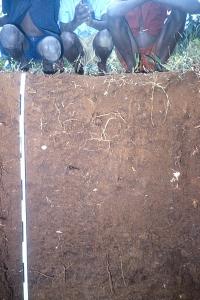Reference soil Kenya 46: Cambisol
Cambisols occur mainly in the temperate and boreal regions of the world, where the soil’s parent material is still young or where low temperatures slow down the processes of soil formation.
Characteristics
Soils having either a cambic horizon (a horizon showing evidence of alteration with respect to the underlying material), or a mollic horizon overlying a subsoil, which has a base saturation of less than 50 percent in some part within 100 cm from the soil surface, or one of the following diagnostic horizons within the specified depth: an andic, vertic, or vitric horizon starting between 25 and 100 cm; a (petro-)plinthic or salic horizon starting between 50 and 100 cm, in absence of loamy sand or coarser textures above these horizons.
Reference soil KE046: Cambisols
Soil fauna: a high activity of termites and ants. At 170 - 200cm a tree trunc piece was found and sampled. Slides: 10,052 - 10,053 and 10,064 - 10,070.
